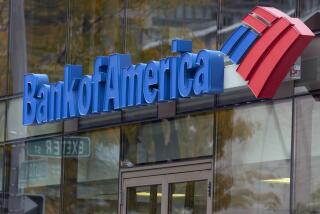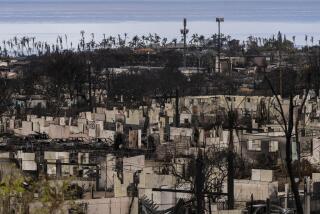Phone Disaster Puts a Glitch in Electronic Age
CHICAGO — All day Friday, bankers trooped to an unmarked car in a secret location in the western suburbs of Chicago where they used code words over a single car phone to transfer millions of dollars.
The unmarked car contained officials from the Federal Reserve Bank of Chicago, and the operation--carried out under the watchful eye of local police in the undisclosed suburban city--was just one of the resourceful ways people here are coping with a telephone disaster of unprecedented proportions.
More than 35,000 residences and 13,000 businesses in the western suburbs have been without telephone service since a Mother’s Day fire destroyed one of the four principal call-switching stations serving metropolitan Chicago.
In addition, service was lost for toll-free 800 numbers and for regional calls that normally flowed through the switching center.
Illinois Bell Telephone, which provides service to the area and operated the switching station in Hinsdale, has kept pushing back the date when service will be restored. Late in the week, the company said it will be mid-June before full service is operating in the affected area.
While the disruption has caused major inconvenience for thousands of residents in the suburbs, the impact on businesses has been devastating. And the scope of the problems raises questions about the emergency plans in place in other major business centers to handle similar disasters.
But one business that had prepared for disaster was Bekins, the household moving company that is based in Glendale, Calif., but has its dispatch operations in Hillside, Ill. After discovering early Monday that both voice and data telecommunications had been cut between the two offices, the company had 22 workers fly from Illinois to California to set up a temporary dispatching operation in Glendale.
“We had 400 to 450 drivers out on the road with no way to call in for instructions or new jobs,” said Kevin L. Cooper, Bekins’ director of customer services. “Pacific Bell installed numerous temporary phone lines, and we put in an 800 (toll-free) line so our drivers can call in from anywhere in the country. We also used our network of agents around the country to help get word out to the drivers.”
Cooper said disaster training had pinpointed the company’s potential vulnerability to disruption of communications--especially for switching billing and shipping data back and forth between California and Illinois.
There were no figures available on how much money has been lost to Chicago businesses, but estimates run well into the millions.
“How do you know how much business you lost because your customers couldn’t reach you?” asked Henry Dreisilker, president of an electric motor repair firm in suburban Glen Ellyn. His company was preparing to send out 13,000 postcards nationwide to customers, giving the numbers of three cellular telephones the firm has placed in cars now sitting in parking lots.
Sears, Roebuck & Co. was forced to reroute telephone orders coming in to its Chicago catalogue sales center from all over the country to San Antonio, Tex. Company officials said the volume of orders had dropped from 4,000 a day to about 2,300.
The Holiday Inn motel chain moved 50 of its 450 reservations operators from suburban Oakbrook Terrace to Raleigh, N.C., and another 25 to its headquarters in Memphis, Tenn.
The Hinsdale fire cut all telephone communications--local and long distance--for phones with dialing prefixes served by that switching center. All long-distance carriers were abruptly cut off from their customers.
MCI Communications helped a major financial information firm by mounting a radio transmitter at the customer’s office and beaming traffic directly to MCI’s long-distance network--bypassing Illinois Bell. MCI also opened its plant in suburban Downers Grove to the public through this weekend so people could make long-distance calls from phones there.
Businesses heavily dependent on phone service often lease extra lines routed through different switching centers, said Robert L. Kamba, director of network management for MCI in Hayward, Calif. That way, he said, if fire or some other calamity wrecks one facility, service can be maintained through the other.
Fiber-Optic Cable
Major long-distance carriers, such as MCI and American Telephone & Telegraph, are building protective rings of fiber-optic cable around major metropolitan areas so that if a breakdown occurs, traffic can be diverted around the ring in either direction from the rupture to a switching center that is working.
“What you wind up with is backups on backups,” said David McKay, AT&T;’s network operations manager in Corona, Calif.
Meanwhile, there were questions here about whether insurance would cover the losses, even for companies that have bought policies covering business interruptions. The problem appeared to be that most of those policies were designed to cover fires or floods and do not contemplate losses stemming from the disruption of telephone service.
For the 80 to 100 banks located in the affected area, the loss of telephone service meant that more than 300 automated teller machines were out of commission because they use telephone lines to communicate with the main bank.
More importantly, in an age when money is represented by electronic blips carried over phone lines between computers, the banks had to find an alternate way to transfer millions of dollars in and out of their accounts at the Federal Reserve Bank.
The accounts are to banks what a checking account is to an individual customer, and without access to them the banks could be forced to shut down.
The Fed first responded by opening an emergency center at its downtown Chicago headquarters so bankers could come downtown to make the transfers. But the decision was quickly changed and Fed officials were dispatched in cars equipped with cellular telephones to serve banks.
Earlier in the week, three of the cars were cruising between banks and allowing local bankers to make their transfers on the car phones. By the end of the week, however, some banks had established alternate methods of communication and the operation had been pared down to a single car in a parking lot.
“Surprisingly, it’s working fairly smoothly,” said William C. Conrad, senior vice president in charge of electronic transfers at the Federal Reserve Bank here.
“For security reasons, we don’t really want to disclose to the public where the car is, and we’ve arranged for local police to keep watch on it,” he added.
Because cellular phone transmissions are not as secure as those over regular telephone lines, the bankers and the Fed officials used a series of code words to ensure that the money was going to the right accounts.
By Friday afternoon, Conrad said about 75 banks were still using the mobile-phone service and, while exact figures were not available, millions of dollars were being transferred regularly over the car phone.
Douglas Frantz reported from Chicago and Bruce Keppel from Los Angeles.
More to Read
Sign up for Essential California
The most important California stories and recommendations in your inbox every morning.
You may occasionally receive promotional content from the Los Angeles Times.










